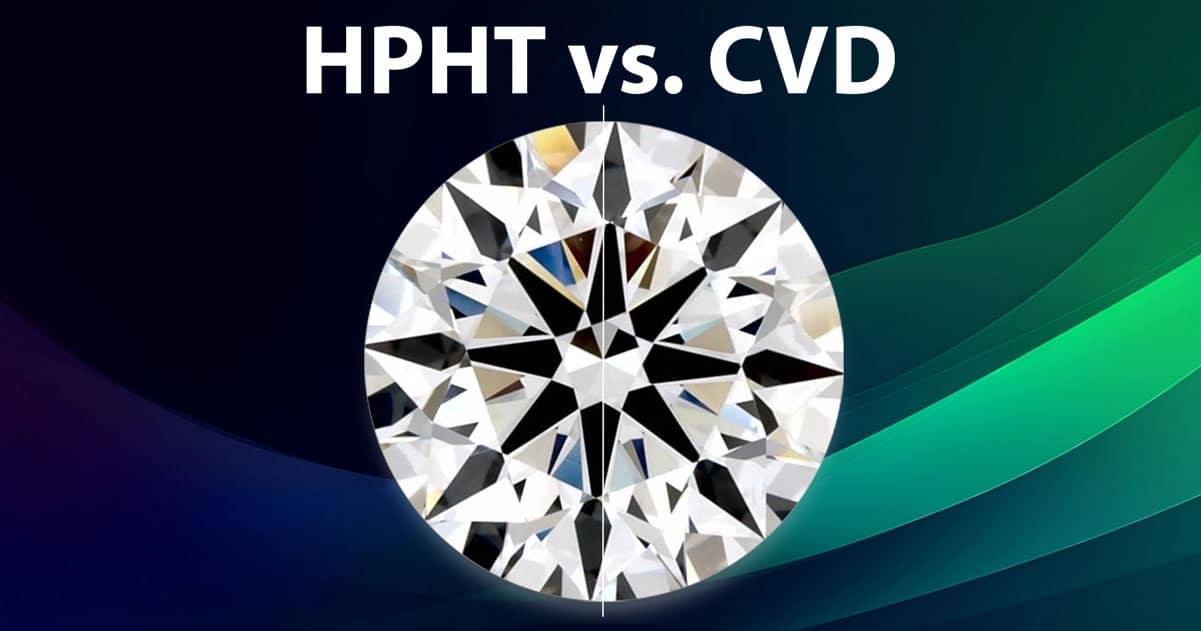
As the demand for sustainable and ethical jewelry rises, more people are turning to man made diamonds. These diamonds are physically, chemically, and optically identical to mined ones—but are created in laboratories using advanced technology. Among the various production methods, two techniques dominate: High Pressure High Temperature (HPHT) and Chemical Vapor Deposition (CVD). Understanding the differences between HPHT vs CVD diamonds is essential for anyone considering a lab-grown diamond. Each method results in stunning gemstones, but they vary in formation process, cost, appearance, and characteristics.
What Are HPHT Diamonds?
HPHT stands for High Pressure High Temperature, a process that mimics the natural conditions under which diamonds form deep within the earth. A small diamond seed is placed into carbon and subjected to extreme pressure and high heat—similar to the natural diamond formation process. This forces carbon atoms to crystallize around the seed, creating a man made diamond.
HPHT diamonds have been around longer than CVD diamonds and are known for producing high-clarity stones with excellent thermal conductivity. Because this method replicates nature so closely, it often results in diamonds with fewer internal stresses. However, HPHT diamonds can sometimes have a metallic hue due to the metal catalysts used during the process. These can typically be removed or minimized during cutting and polishing.
What Are CVD Diamonds?
CVD, or Chemical Vapor Deposition, is a newer, more modern method for creating man made diamonds. It involves placing a diamond seed into a vacuum chamber filled with carbon-rich gas, such as methane. Once the chamber is heated, the carbon atoms begin to separate and deposit themselves layer by layer on the seed, forming a larger diamond over time.
One of the most important benefits of CVD diamonds is their purity. Because the process doesn’t use metal catalysts, CVD stones are typically free of metal impurities. In the debate of hpht vs cvd diamonds, CVD is often preferred for creating colorless diamonds or diamonds that require additional color grading. CVD also allows for better control of the diamond’s properties during growth, which is a key reason why the method is growing in popularity.
Appearance and Quality: HPHT vs CVD
When evaluating hpht vs cvd diamonds, appearance is often a major consideration. Both methods can produce high-quality stones, but subtle differences exist. HPHT diamonds typically come out with higher clarity grades right from the start, making them attractive for those who want a very clean-looking stone. However, they may exhibit fluorescence or a slight yellow or brown hue, especially if lower quality materials are used.
CVD diamonds, on the other hand, usually have better control over color. Many high-quality, colorless man made diamonds are grown using the CVD method. These diamonds often undergo post-growth treatments, like HPHT annealing, to enhance their optical properties. With CVD, you can expect a wide variety of shapes and sizes, all with excellent brilliance and symmetry.
Price Comparison and Availability
Cost is always a consideration when shopping for a diamond. When comparing hpht vs cvd diamonds, both methods result in stones that are more affordable than their mined counterparts. However, HPHT diamonds can sometimes be less expensive due to older technology and lower production costs.
CVD diamonds might come with a slightly higher price tag, especially if they’re of exceptional color and clarity. However, both types of man made diamonds offer better value per carat than natural diamonds, allowing buyers to invest in larger or higher-quality stones without the traditional markup.
Availability also varies by jeweler. Some specialize in CVD diamonds due to their growing popularity, while others still rely on HPHT for specific stone types, like fancy colors or specific crystal sizes. As a consumer, it’s helpful to ask your jeweler which method was used in growing your diamond and what that means for its long-term performance.
Durability and Performance
Both HPHT and CVD diamonds are extremely durable, scoring a perfect 10 on the Mohs hardness scale. This means either type is suitable for everyday wear, such as in engagement rings or other fine jewelry. In terms of durability, there’s virtually no difference between hpht vs cvd diamonds.
However, performance under magnification can differ. CVD diamonds may show what gemologists call “strain patterns” or graining under polarized light, a result of internal stress during growth. HPHT diamonds, in contrast, are typically stress-free and more uniform in crystal structure. For everyday wear, these differences are imperceptible, but they may matter to those with a keen eye or technical interest in gemology.
Ethical and Environmental Considerations
Both HPHT and CVD are far more sustainable than traditional diamond mining. The environmental impact is significantly lower, and these diamonds avoid the human rights issues associated with some mining operations. When considering man made diamonds, the production method generally doesn’t affect the ethical standing—both are clean and conflict-free.
That said, some consumers prefer CVD diamonds due to the perceived “cleaner” process—especially since no metal catalysts are used. However, advancements in HPHT have made it more energy-efficient and less reliant on heavy metals, narrowing this ethical gap.
Certification and Identification
All high-quality man made diamonds, whether HPHT or CVD, should come with grading certificates from reputable labs like IGI or GIA. These certificates detail the diamond’s characteristics including cut, clarity, color, carat, and the method of creation.
In the professional gemological world, hpht vs cvd diamonds can often be distinguished using advanced testing equipment. For consumers, though, both appear identical in beauty and structure. Most jewelers disclose the growth method upon request, and it’s often listed on the certification document.
Which One Should You Choose?
The choice between hpht vs cvd diamonds often comes down to your personal priorities. If you want a diamond with high clarity and don’t mind a warmer tone or some fluorescence, HPHT may be ideal. On the other hand, if you’re looking for a diamond with superior color purity and no metal traces, CVD might be the better option.
Both methods produce gorgeous, genuine man made diamonds that stand the test of time. Rather than focusing solely on the method, it may be more helpful to look at the individual characteristics of the stone—its brilliance, balance across the 4Cs, and how well it matches your aesthetic.
Final Thoughts: HPHT and CVD Are Both Excellent Choices
The growing popularity of man made diamonds has brought new excitement and choice to the world of fine jewelry. Whether you prefer HPHT or CVD, both methods represent innovation, sustainability, and affordability without compromising on beauty or durability.
By understanding the key differences in hpht vs cvd diamonds, you can make a more informed decision and choose a diamond that reflects your values, style, and budget. No matter the choice, you’re investing in a future where luxury and responsibility go hand in hand.






Weather Situations When H11/H8/H9 LED Headlight Bulbs Be Used
How To Live The Happy Live As A Wheelchair User
Why Prefer Eat Verification Website?
Fenix International Limited stock: what you need to know
How to Set Up The Perfect Home Office